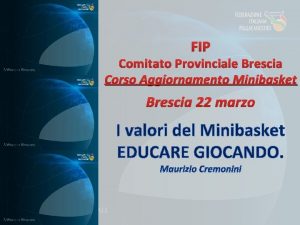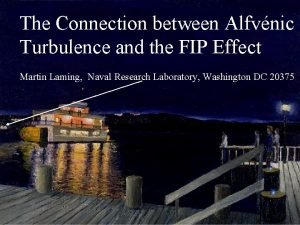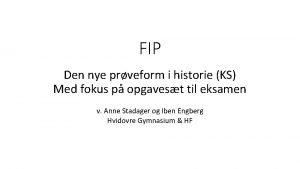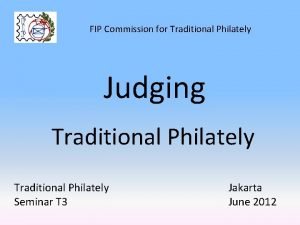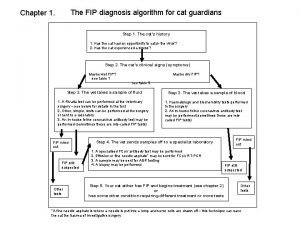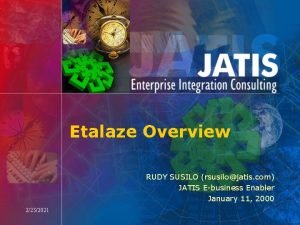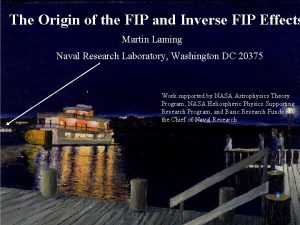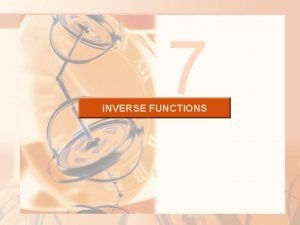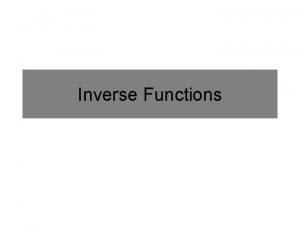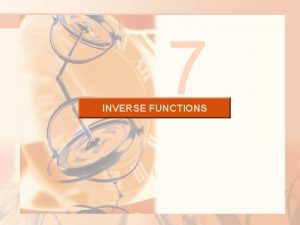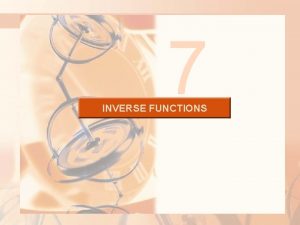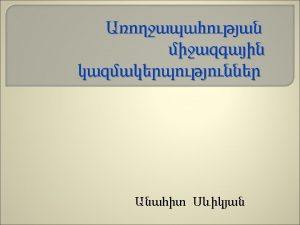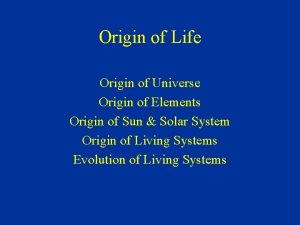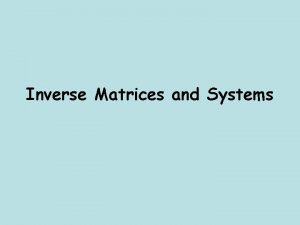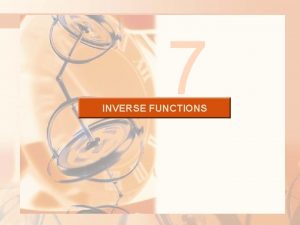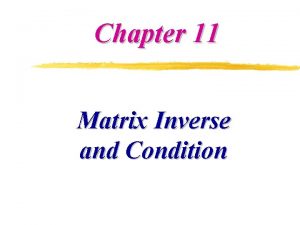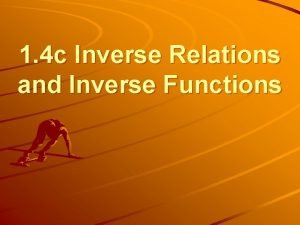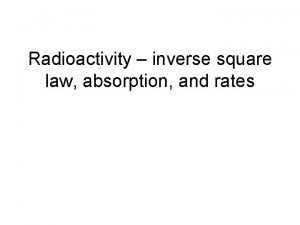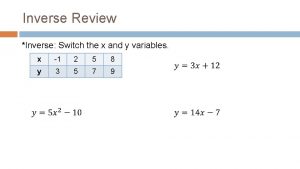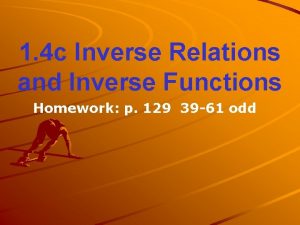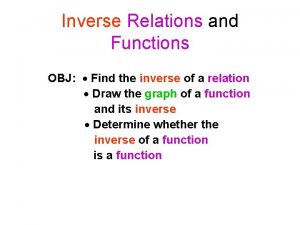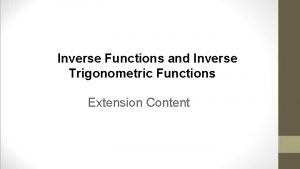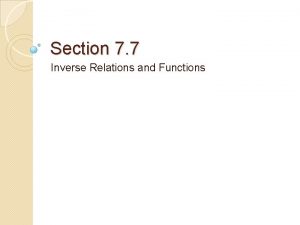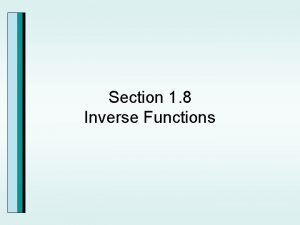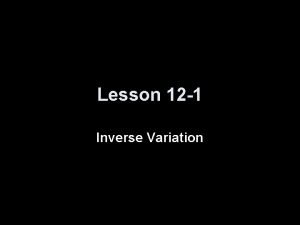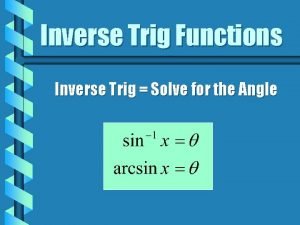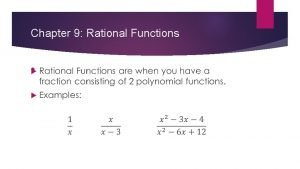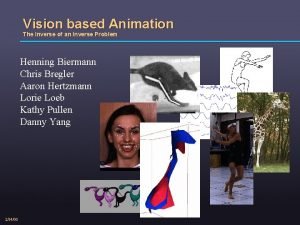The Origin of the FIP and Inverse FIP































- Slides: 31

The Origin of the FIP and Inverse FIP Effects Martin Laming Naval Research Laboratory, Washington DC 20375 Work supported by NASA Astrophysics Theory Program, NASA Heliospheric Physics Supporting Research Program, and Basic Research Funds of the Chief of Naval Research

Plan of Talk 1. 2. 3. 4. Introduction to FIP model and Ponderomotive Force Open and (Closed) Field Helium Fractionation + Inverse FIP +

Elemental Fractionation • FIP Effect known (suspected) since Pottasch (1963, Ap. J, 137, 945). • Now understood (Laming 2015, LRSP, 12, 2; also 2004, 2009, 2012) as due to action of ponderomotive force in chromosphere. • 25 – 100 km s-1 waves give correct fractionation for all elements observed. Easily measurable with correct instrumentation. • Higher fractionation (higher amplitude waves) in fast CME ejecta. x x x x (from Reames 2014, Solar Physics, 289, 977)

What is the Ponderomotive Force? J. D. Barrow, "Much ado about nothing", (2005) Lecture at Gresham College. (Includes discussion of French naval analogy. ) Wave modes unrestricted Net force Wave modes restricted by boundary conditions

Ponderomotive Force Derivations fz = ½ rc 2∂(d. E┴ 2/Bz 2)/∂z 1. Lagrangian for particles + wave & energy partitioning in Alfvén waves (Laming 2009; 2015) 2. Single particle equations of motion in E & B fields (Lundin & Guglielmi 2006) 3. Polarization and magnetization produced by waves (Laming 2016) 4. Change in e produced by passage of Alfvén wave (Pitaevskiĭ 1961; Washimi & Karpman 1976)

Fractionation (following Schwadron, Fisk & Zurbuchen 1999) Fractionation = exp x a (neff / ni) / vs 2 dz where x a (neff/ni) =(element ion fraction) x (acceleration) x nn/[xnn+(1 -x)ni], nn, ni are element collision rates for neutrals and ions vs 2 = k. T/mi + vmturb 2 + v. SM 2 (+ vflow 2 ); thermal speed + longitudinal turbulent, slow mode, and flow velocities Compute Alfvén propagation on loop.

Plan of Talk 1. 2. 3. 4. Introduction to FIP model and Ponderomotive Force Open and (Closed) Field Helium Fractionation + Inverse FIP +

Chromospheric Structure 1000 km b≈1 Chromospheric model from Avrett & Loeser (2008) at each footpoint 1000 km Force Free Magnetic Field (Athay 1981)

Coronal Wave Patterns Resonant Frequency is 0. 065 rad s-1 a – Elsässer variables, b – wave energy fluxes, c – ponderomotive acceleration a b c

Chromospheric Footpoint (resonant) a – Temperature and density, b – ponderomotive acceleration and slow mode waves, c –ion fractions (detail). , d – FIP fractionation and ion fractions a c d b

Open vs. Closed Field open closed

FIP Effect in Slow/Fast Wind (taken from Bochsler 2007 with model points rel. to O)

Hyperion Simulations Dahlburg, Laming, Taylor & Obenschain (2016), Ap. J, in press 3 D compressible MHD, footpoint motions stress magnetic field followed by episodic energy release in the corona

Ponderomotive Acceleration and Coronal Temperature in Simulations (need ~104 m s-2)

Plan of Talk 1. 2. 3. 4. Introduction to FIP model and Ponderomotive Force Open and (Closed) Field Helium Fractionation + Inverse FIP +

He/H =0. 052+/- 0. 005 in the Solar Corona Laming & Feldman (2001) Ap. J, 546, 552 Laming & Feldman (2003) Ap. J, 591, 1257 He II 1084. 94 88”-118” off limb 243”-273” off limb Relative to N II 1083. 98, 1084. 58, and the blend of 1085. 53/1085. 55/1085. 68 Å (all scattered light from the disk) He II 1084. 94 is stronger at the lower altitude, indicating a true He II coronal emission component in.

HERSCHEL I Results (Fineschi et al. 2010, 2014) HEIT and HECOR He II 304 HEIT He II, SCORE Ly. A and He II

HERSCHEL I Results Lya intensity He/H abundance (normalized) See also Laming & Feldman (2001; 2003) He/H peaks at the streamer-CH boundaries for all heights (1. 5, 1. 7, 1. 9, 2. 1 Rs)

Alfvén Waves have Coronal Origin: Nanoflares? B=5, 10, 15, 20 G L=50, 75, 100 Mm Rakowski & Laming (2012) • He/O depletion strongest for waves resonant with coronal loop w = npv. A/L, longer loops, weaker B • Resonance only guaranteed with coronal origin nanoflares • Reconnection/Alfvén resonance Alfvén waves heating distributed throughout loop. No localized hot plasma as evidence of nanoflares.

Solar Wind Abundances Through the Solar Cycle He/H: Kasper et al. (2008) He/O: Rakowski & Laming (2012) Ne/O: Shearer et al. (2014) Landi & Testa (2014)

Schmelz et al. (2012), Figure 1. Variation of S abundance? Low S/O fractionation at top of chromosphere closed field High S/O fractionation (lower in chromosphere or lower H ionization or both) Clue to solar wind origin?

Plan of Talk 1. 2. 3. 4. Introduction to FIP model and Ponderomotive Force Open and (Closed) Field Helium Fractionation + Inverse FIP +

Stellar Coronae: Wood & Linsky (2010, Ap. J, 717, 1279)

Inverse FIP Effect (Warren, Doschek & Feldman 2015, Ap. J, 808, L 7

Inverse FIP by Reflection of Upward Fast Mode Waves

Genesis Crash 9/8/2004

Comparison with Genesis results relative to Mg (from Heber et al. 2012 ab, Mc. Keegan et al. 2011, Marty et al. 2011, Rieck et al. unpublished, Burnett private communication, …)

Conclusions: Scientific Importance • Completely unexpected, but by now well documented phenomenon. • Connection with Alfvén waves offers novel and unexpected diagnostics of wave motions in the chromosphere and corona, that cannot be achieved by any other means, leading to a so far completely untried approach to the problem of coronal heating. • Determination of rare gas abundances from coronal and solar wind observations. These elements have no photospheric lines. He is currently best determined from helioseismology. • Further connections with helioseismology through wave physics in the outer solar atmosphere; reflection/refraction, transmission, mode conversion of solar p-modes and MHD waves.

Type II Spicules Do Not Supply Mass or Energy to the Solar Corona or Wind vs 2 = k. T/mi + vmturb 2 + v. SM 2 + vflow 2 Type II spicules Laming, Drake & Widing (1995) • Full disk solar spectrum of Malinovsky & Heroux (1973) analyzed by Laming et al. (1995) • FIP Effect changes at log. T ~ 5. 8 • See also Young (2005 ab); Feldman & Widing (1993); Young & Mason (1998) • “Transition Region” and corona must be physically separate (e. g. Feldman & Laming 1994) • TR UFS (Feldman 1983; 1987; 1998), Type II Spicules (e. g. Martínez. Sykora et al. 2011), which do not reach coronal temperatures (c. f. de Pontieu et al. 2011; Mc. Intosh et al. 2011, Judge et al. 2012) • But remember Procyon!

The FIP Effect in Other Stars? Solar Spectrum: Malinovsky & Heroux, 1973, Ap. J, 181, 1009 Procyon Spectrum: Drake, Laming, et al. 1995, Science, 267, 1470 Sun Fe XV Fe/S is very different in coronae, but the same in photospheres. Why? Procyon Fe IX S XI Fe XIII

Solar Wind Abundances Through the Solar Cycle He/H: Kasper et al. (2008) He/O: Rakowski & Laming (2012) Ne/O: Shearer et al. (2014) Landi & Testa (2014)
 Fip lombardia brescia
Fip lombardia brescia Fip
Fip Come compilare un referto di basket
Come compilare un referto di basket Fip historie
Fip historie Fip philately
Fip philately Fip diagnosis flowchart
Fip diagnosis flowchart Epartners fip
Epartners fip Hát kết hợp bộ gõ cơ thể
Hát kết hợp bộ gõ cơ thể Lp html
Lp html Bổ thể
Bổ thể Tỉ lệ cơ thể trẻ em
Tỉ lệ cơ thể trẻ em Chó sói
Chó sói Chụp phim tư thế worms-breton
Chụp phim tư thế worms-breton Hát lên người ơi
Hát lên người ơi Kể tên các môn thể thao
Kể tên các môn thể thao Thế nào là hệ số cao nhất
Thế nào là hệ số cao nhất Các châu lục và đại dương trên thế giới
Các châu lục và đại dương trên thế giới Công của trọng lực
Công của trọng lực Trời xanh đây là của chúng ta thể thơ
Trời xanh đây là của chúng ta thể thơ Mật thư anh em như thể tay chân
Mật thư anh em như thể tay chân Làm thế nào để 102-1=99
Làm thế nào để 102-1=99 độ dài liên kết
độ dài liên kết Các châu lục và đại dương trên thế giới
Các châu lục và đại dương trên thế giới Thơ thất ngôn tứ tuyệt đường luật
Thơ thất ngôn tứ tuyệt đường luật Quá trình desamine hóa có thể tạo ra
Quá trình desamine hóa có thể tạo ra Một số thể thơ truyền thống
Một số thể thơ truyền thống Cái miệng bé xinh thế chỉ nói điều hay thôi
Cái miệng bé xinh thế chỉ nói điều hay thôi Vẽ hình chiếu vuông góc của vật thể sau
Vẽ hình chiếu vuông góc của vật thể sau Thế nào là sự mỏi cơ
Thế nào là sự mỏi cơ đặc điểm cơ thể của người tối cổ
đặc điểm cơ thể của người tối cổ Ví dụ giọng cùng tên
Ví dụ giọng cùng tên Vẽ hình chiếu đứng bằng cạnh của vật thể
Vẽ hình chiếu đứng bằng cạnh của vật thể
